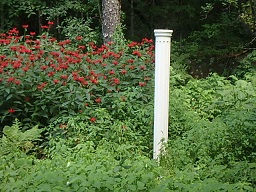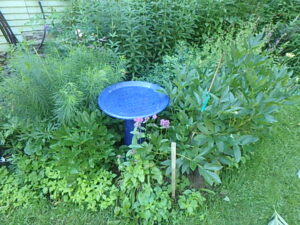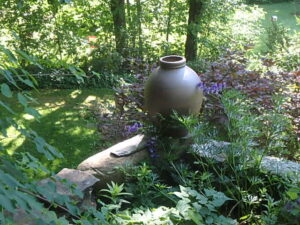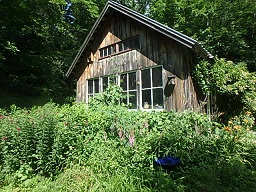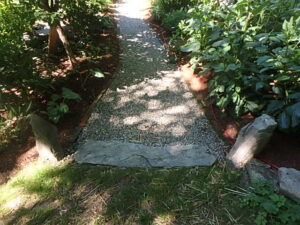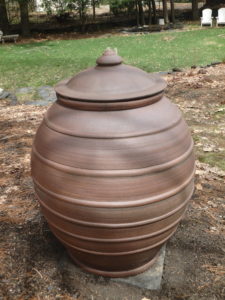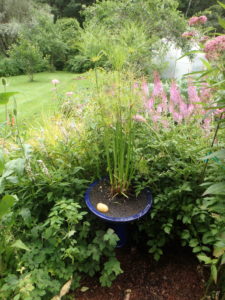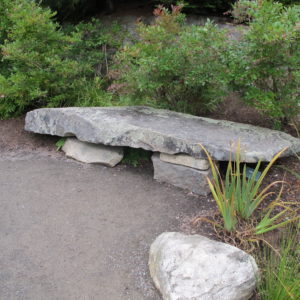Beyond Perennials: Making Your Garden a Very Special Place.
My garden is the place I go in times of sadness, worry or stress. It makes me feel better. I took a few moments one morning recently to really look at what was in my garden to see what made it so special. I saw that in addition to the plants (and who cannot be happy snacking on red raspberries or Sun Gold cherry tomatoes?), I have many things that remind me of friends, and of good times. Let’s take a look at my garden, and perhaps you’ll get some inspirations for what to do in yours.
I have three nice Japanese red maples that bring fond memories. Two came from my parent’s home in Connecticut, another from a friend. I dug 2 them as foot-tall saplings, one bigger. The one I planted in the early 1970’s and it is now 10 feet tall and wide with a 6-inch diameter trunk at the base. I see it and often think of the 60-foot tall “mother plant” I climbed as a boy.
Other things are easier than stone projects. I have two nice blue ceramic bird baths. They contrast nicely with the flowers around them, even though no birds ever bathe there. But I love the water in them, and that my wife Cindy Heath floats cut flowers in them. (Yes, my longtime partner and I finally got married July 1 in a Zoom wedding attended by loved ones all over.)
I have a lovely high-temperature fired urn in the garden, a birthday present from Cindy this year. It makes me happy every time I see it. It has a drainage hole and the potter, Stephen Proctor of Brattleboro, Vermont, tells us that it can stay outside all year. Always a bit of a worrier. I will bring it inside before Christmas. It’s too nice to risk having it crack.
Then there is my 16- by 20-foot barn. I had a barn raising event in the late 1990’s and had more than 30 friends show up. My late friend Bernice Johnson, then in her eighties, showed up with a little hammer in her hand. It makes me happy when I think of that day, and that we got the walls up and rafters on in one day. And now Cindy keeps it tidy inside – something I never managed to do.
I love the perennials I have gotten from friends and from gardeners I have interviewed. I remember every plant given to me, who gave it to me, and often when I got it. It’s part of what makes my garden so special to me. Now I tend to add little white plastic tags labeled with that information so it will be available even if I am not always around to provide that information.
Creating a Great Garden: It’s More Than Just Plants
If you’ve visited any great gardens, you know that they consist of more than just flowers. They have fine trees and shrubs, pathways, perhaps stonework or pottery, maybe a bit of whimsy, or walls and great views. Now, before your trees are fully leafed out and the perennials have begun to distract you with their blossoms, this is a good time to think creatively about what you can do to make your garden spaces better.
I recently visited the Inn on Putney Road, a B&B in Brattleboro, Vermont. This is a majestic old white brick building with lots of formal gardens. I went to see it because I had seen the outdoor pottery of Steve Procter (https://www.stephenprocter.
Steve Procter makes pots that are high-fired and impervious to the elements. Unlike flower pots, his pots are fully vitrified, and will not absorb moisture. Most are not designed for use as flower pots, but for their amazing looks. The come with lids and a drainage hole. In the summer, they may be displayed without the lid, and rain will not collect inside. In the winter lids are recommended to avoid any ice building up.
These pots would make my garden look even better than it does. But a 5-foot tall pot takes Steve about 3 weeks to make and a full day at 2300 degrees F to bake – and days to cool it slowly. These are not inexpensive, obviously, and not in my budget just now.
Steve told me that although people are used to placing 2-dimensional art work on the walls of their homes, 3-dimensional art is less common and not everyone is comfortable placing big pots in the garden, He generally delivers the pots and helps to find a perfect spot for each. The pots are placed on a square of bluestone or concrete to keep them steady.
Whether you are placing a pot, a sculpture or perhaps a tall standing stone, 3-dimensional art can provide a visual destination, something that draws a visitor down a path. And if you partially conceal the pot or art with a shrub or tree, Steve Procter pointed out that it can create a sense of mystery. Or provide a surprise when you turn a corner.
Large flower pots filled with plants add much to a garden, too. I have a fig tree and a Frangipani (the tree that provides flowers for Hawaiian leis) in ordinary big pots – but have to bring them in each winter. That can be a struggle. But they can add a lot to my landscape.
What else can one do to provide 3-dimentional interest? A simple ceramic bird bath adorns my garden each summer. Since the birds showed no interest in taking baths in it (I also have a stream nearby), I use it as a pedestal for a plant in a pot, or even as a shallow pot. Last summer I grew papyrus in it. Papyrus grows in standing water, which is good as a bird bath collects water and would drown many plants in a rainy time.
Standing stones are also wonderful. A significant part of the stone must be buried in order to achieve stability. I think the perfect stone is long and relatively narrow with a base that is wider than the exposed portion when installed. I prefer stones that are 4 to 6 feet from end to end and just a foot to 18 inches wide.
To make a standing stone stable, I dig a hole 18 to 24 inches deep and 2 to 3 feet wide. Once I have the stone standing in the hole and vertical, I place stones around it in the hole. I choose stones the size of a loaf of bread or bigger to hold the stone in place. Then I pour into the hole a bag of ready-mix concrete, dry. The concrete will harden up and cure nicely over time. I finish filling the hole with topsoil.
When I install standing stones in public places I make each even more stable by digging a mushroom-shaped hole. I dig the hole, then dig out laterally at the bottom to create a pocket under the un-excavated sides of the hole. This space gets filled with concrete mix, making a nice anchor. I use a hand tool called a CobraHead weeder to pull the soil out of the pocket area.
What else can you use to spiffy up your garden? Benches are nice. Wooden benches are probably the most comfy. Stone benches look great, but are cold and hard to sit on for more than a few minutes. But any bench will draw the eye, and encourage visitors to approach the bench.
I have a marble bench next to my brook where there is a nice planting of umbrella plant (Darmera peltata). I placed some of my late sister Ruth Anne’s ashes under the umbrella plant at planting time, and it has been a nice quiet place to sit and remember her, particularly when it blooms in the spring with tall pink flowers.
So look for some three-dimensional objects to enhance your garden – whether pots or standing stones or even an old fashioned gazing ball. And remember: you don’t have to prune or weed them!
Henry Homeyer is a garden writer, consultant, gardening coach, and the author of 4 gardening books. He can be reached at henry.homeyer@comcast.net.



